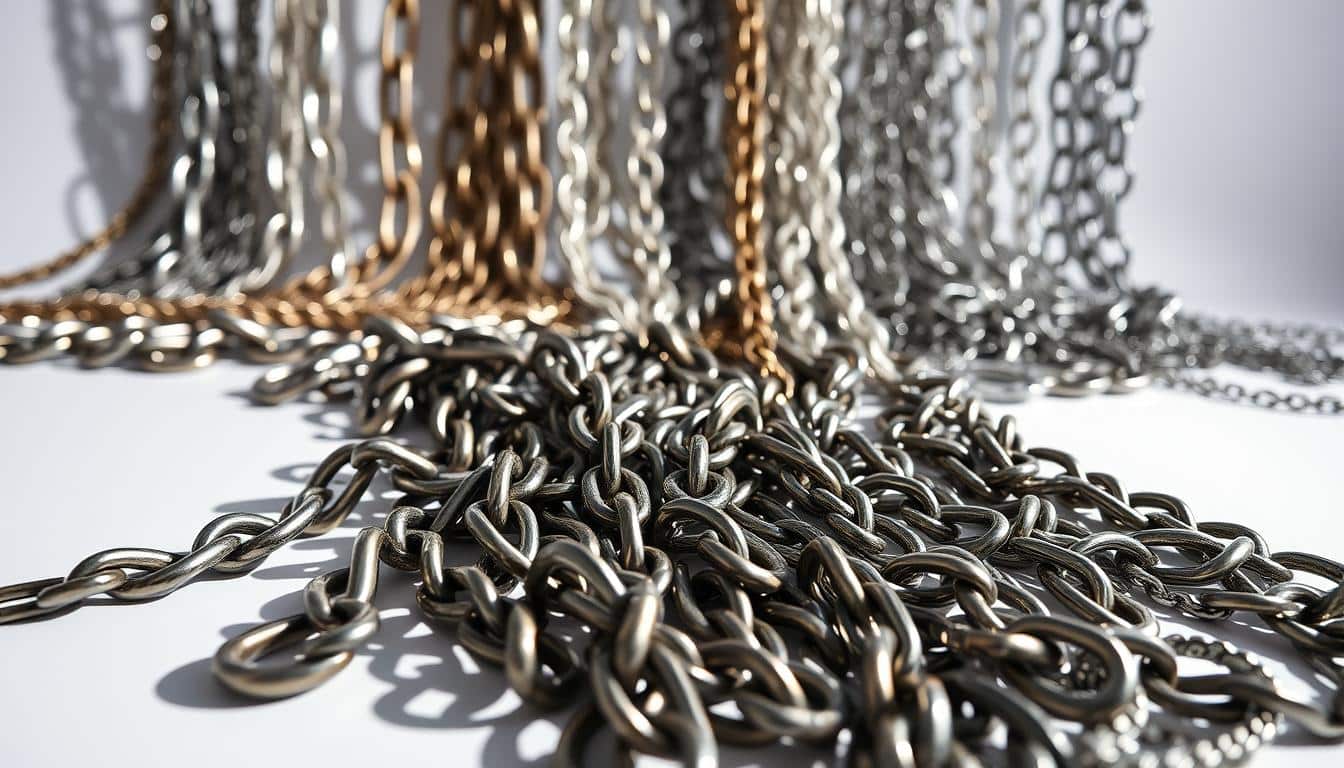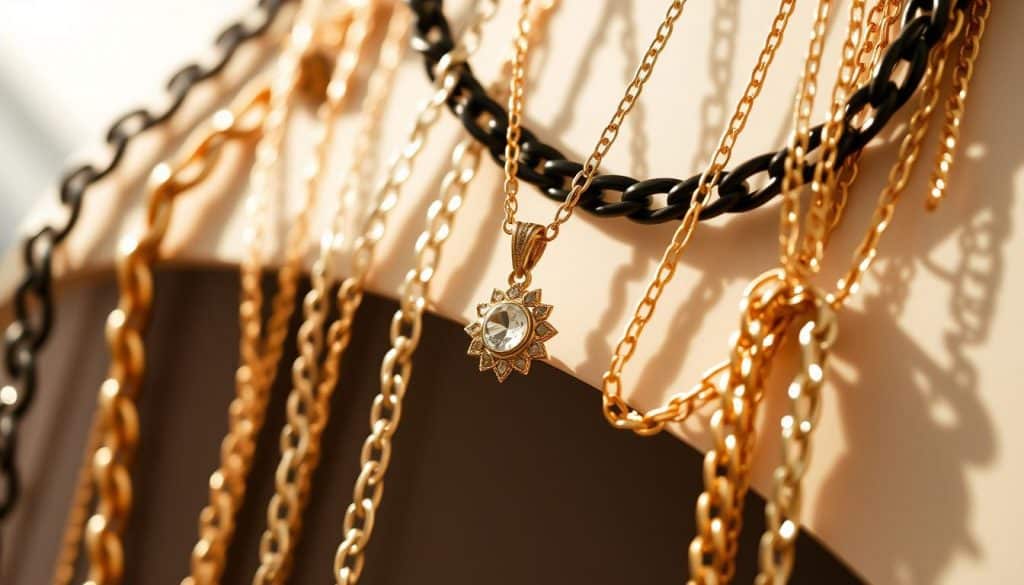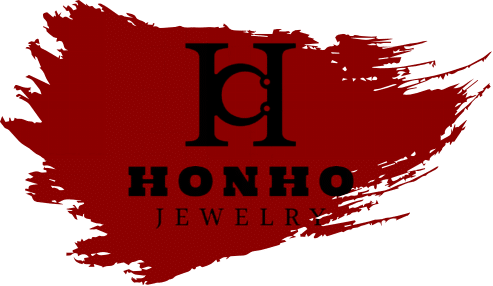Discover the Different Types of Chains

We open with a clear market framing for chain selection in modern jewelry. Our guide maps common weaves — from cable and box to rope and curb — and explains how geometry drives strength, drape, and the final look.
We focus on practical sourcing rules. Short notes cover repairability, solid versus hollow builds, clasp fit, and pendant compatibility. These factors shape cost, warranty risk, and resale value.
For wholesale buyers, we recommend stocking versatile cable and curb for steady sales, plus a few bold pieces to refresh assortments today. We also highlight service needs: soldered joints, finishing, and handling that reduce returns.
Use this section as a quick decision tool. It outlines selection criteria we apply when choosing chain types and modern styles for layered looks and single-statement pieces.
Key Takeaways
- Geometry determines performance: choice affects strength and drape.
- Stock repairable, pendant-friendly options for broad appeal.
- Mix proven sellers with a few contemporary pieces to refresh assortments.
- Production details—solid vs hollow, soldering, finish—drive longevity.
- Buyer education on care reduces warranty events and preserves look.
What “types of chains” means today in jewelry: scope, uses, and look
We organize current offerings by construction, wear profile, and visual impact. The core families include classic link chains (cable, rolo/belcher, paperclip), flat forms like curb and Figaro, rounded ropes and wheat, plate-over-mesh omegas, and specialty weaves such as Byzantine and mesh.
Use cases vary. Cable and wheat carry pendants with ease. Curb, Figaro, and anchor perform well as hero necklaces. Herringbone and omega demand careful storage to avoid damage.
- Taxonomy: grouped by link architecture, drape, and service profile over time.
- Merchandising: pendant carriers versus stand-alone pieces guide SKU roles.
- Aesthetics: refined edges, nautical references, and high-polish finishes define the look and style.
- Engineering: oval links and ring geometry affect flexibility and perceived volume at a given gram weight.
- Serviceability: open-architecture chains are easier to repair than dense woven constructions.
“Stock depth by family and checks on solder integrity, link uniformity, and finish consistency reduce returns and preserve brand value.”
We recommend stocking across families so size runs and finishes meet demand curves. Prioritize sourcing checkpoints to ensure repeatable quality for wholesale buyers in the United States market.
How to choose a chain: style, strength, flexibility, and pendant compatibility
Choosing the right chain hinges on matching build, bail clearance, and intended wear. We start with link geometry, then weigh flexibility and repairability. That order keeps procurement simple and reliable for wholesale buyers.
Link shape and construction
Link form and join method set load capacity and bail clearance. Cable chains use uniform round or oval links and, when soldered, deliver excellent serviceability for daily pendants.
Box or Venetian pieces show square edges and bright facets. They suit light pendants but can catch hair and twist if too thin.
Flexibility versus rigidity
Wheat and cable deliver balanced flexibility and strength, ideal for routine wear and layering. Snake chains drape smoothly but can kink and require careful repair.
Herringbone and omega are rigid and prone to irreversible flat spots. Avoid heavy pendants on these profiles.
Pendant bails, layering, or worn alone
Match bail diameter to chain diameter and edge geometry to prevent snagging. Rope chains give redundancy and resilience for mid-weight pendants, while ball chains suit only light pieces.
Practical checklist:
- Prefer soldered joins for daily wear to reduce pull-apart risk.
- Pick chain diameter to balance durability without overwhelming small pendants.
- Anticipate repair complexity: cable link replacement is simple; woven restorations are costlier.
- Store rigid profiles flat and protected to avoid kinks and permanent damage.
Classic link foundations: cable, rolo/belcher, and paperclip variations
Three established link families set the standard for pendant support and visual weight in modern assortments. We evaluate each for durability, finish, and SKU role so buyers can match inventory to demand.
Cable chain
Cable chains use uniform round or oval links. Soldered joins improve strength and simplify repairs. For pendant work and layering, cable chain remains the go-to due to its predictable service life.
Rolo / Belcher
Rolo pieces pair a rounded exterior with a flatter interior. This cross-section increases perceived heft without extra metal. Use rolo for a fuller look in men’s bracelets and mid-weight necklaces.
Paperclip / Trombone
Elongated oblong links connected in series create visual volume with lower gram cost. This variation is flexible and fashionable but needs temper control to reduce bending risk in long links.
| Profile | Visual | Best Use | Service Notes |
|---|---|---|---|
| Cable | Classic, balanced | Pendants, layering | Solder joins reduce warranty claims |
| Rolo/Belcher | Round exterior, flat interior | Bracelets, mid-weight necklaces | Appears heavier; easy to finish |
| Paperclip/Trombone | Elongated, airy | Statement pieces, cost-efficient gold | Requires hardening to limit bends |
Recommendation: Use fine cable as a base layer, add a paperclip mid-layer for rhythm, and select rolo where a round profile increases perceived value.
Box chains (also known as Venetian chain): modern cubic elegance
We examine how folded flat wire becomes a precise cubic profile that defines a modern aesthetic. The box profile forms when flat stock is folded into small cubes, producing uniform links with crisp edges.
Design details: square pattern and bright edges
Square faces reflect light for pronounced sparkle. Edge polishing and diamond-cut finishing boost brilliance without weakening the geometry.
When to pick this profile: pendants, sparkle, and drawbacks
Choose a box chain for minimalist design and lightweight pendants. It drapes well and layers cleanly with cable and wheat options.
- Flat-to-cube forming yields consistent geometry and modern lines.
- Polish and diamond-cut options amplify sparkle while preserving strength.
- Gauge selection balances pendant support with comfort and tangle resistance.
- Caution: edges can catch hair and long pulls may stretch or stiffen segments.
“Pair box chains with small bails and lightweight charms to avoid torque and twisting.”
Ball chain (bead chain): textured spheres for casual to luxe looks
Ball and bead designs give a tactile surface that reads casual yet can go luxe when finished in precious metal.
Bead assemblies pair spherical beads with short connector bars. The result is a semiflexible profile where beads slide slightly on the bars. This delivers measured flexibility and a rhythmic drape.
Solid vs. hollow beads, connector bars, and service notes
Solid beads increase durability and tensile strength. Hollow beads cut gram weight and cost. Both suit light pendants, but heavy charms will stress the bar-bead interface and can fail.
- Connector bars govern movement and local stress points.
- Repairs are difficult; bead replacement is labor intensive.
- Polish and plating specs should target consistent surface grain for luxury finishes.
- Merchandise as textured add-ons to smoother pieces for layered looks.
| Feature | Solid Bead | Hollow Bead | Best Use |
|---|---|---|---|
| Weight | Higher | Lower | Heavy vs. light pendants |
| Durability | Strong | Moderate | Daily wear vs. entry-price |
| Repair | Moderate | Challenging | QA on bead integrity |
Recommendation: Inspect bead seating at inbound QA and choose clasps that match bead geometry for a seamless finish.
Rounded and fluid profiles: snake, wheat/spiga, rope

Smooth, braided, and twisted forms each present a unique balance between drape and durability.
Snake features tightly joined links that form a sleek tube with a subtle chevron. It drapes elegantly and reads minimal on the neck. Handle it carefully; kinks show and repairs are visible. We recommend light charms and careful storage for this profile.
Wheat (Spiga) uses twisted, interlocking ovals for a braided surface. It gives strong support for heavier pendants and resists pull-apart stress. Expect more cleaning where the interstices trap debris, but repairability remains good.
Rope offers a classic twisted look. The French variant is tighter and heavier per millimeter. For daily-wear SKUs we favor solid rope chains to reduce denting and simplify service. Rope resists stretch and suits layered or stand-alone pieces.
For QC, torque and clasp tests validate kink resistance and long-term serviceability. Align each profile to buyer demographics and upsell with graduated gauges to scale presence without losing comfort. These rounded styles balance tactile appeal and practical performance.
Flat and patterned links: curb, figaro, anchor/mariner, and more
Flat link profiles deliver bold presence with proven serviceability for wholesale lines. We select these when a retailer needs high-impact necklaces that resist wear and repair cleanly.
Curb profiles and their appeal
Curb uses twisted, flattened oval links for a flat-laying, flexible profile. Diamond-cut facets amplify edge sparkle and retail appeal.
- Why best-sellers: strength, easy repair, and strong visual impact.
- Use thin curb for pendant work; heavy Cuban-style curb for stand-alone statement pieces.
- Upgrade clasps on heavier gauges to keep system strength aligned.
Figaro: repeating rhythm and masculine presence
Figaro alternates short and long links (commonly 3+1). It creates a clear visual pattern that reads as a statement piece.
We position Figaro in men’s and unisex assortments where standalone wear drives margin.
Anchor / Mariner: engineered for load and nautical style
Anchor integrates a vertical center bar inside each link. That bar resists deformation and gives a recognizable motif.
- Versatile: wears alone or with heavier pendants.
- Repair note: requires precise bar alignment during restoration.
- Finish options: mirror polish or selective diamond-cut to define edge and depth.
“Clear signage of link pattern and gauge simplifies in-case comparison and speeds buyer decisions.”
Wide, shiny statements: herringbone and omega differences
We examine two broad, flat profiles that sell by presence and polish rather than bendability. Both read bold on display and require clear handling instructions to protect finish and customer trust.
Herringbone: bold flat V pattern and care considerations
Herringbone uses short, offset V-shaped links to form a continuous, reflective plane. The result is a maximal surface shine and a clean retail look.
It lacks the flexibility of rounded profiles. Twists and kinks are common and repairs rarely vanish.
Omega: plate-over-mesh engineering, domed form, slide pendants
Omega uses crimped plates over a mesh core. This plate-over-mesh build holds curvature and tolerates heavier pendants than herringbone while keeping a domed, mirror finish.
Storage and clasp strength remain critical to avoid plate deformation.
“Use omegas for structured silhouettes and herringbone for single-piece theater; both need premium QC and clear care guidance.”
- QC checkpoints: plate alignment, mesh continuity, curvature memory.
- Merchandising: hero SKU for a single-piece statement; limit layering with delicate carriers.
- Warranty: include care cards and restricted repair coverage to manage expectations.
| Feature | Herringbone | Omega |
|---|---|---|
| Construction | Short V-shaped links | Crimped plates over mesh |
| Durability | Low — prone to kinks | Medium — retains shape better |
| Best use | Single-chain statement | Structured silhouettes, slide pendants |
| Care notes | Store flat; avoid twisting | Support curvature; strong clasp |
Serpentine family and flat link cousins: S-link, C-link, Boston link
Flat-plane profiles deliver a crisp retail presence and require specific handling to preserve their geometry. These low-profile designs read refined on display. They also demand clear merchandising and care protocols.
Serpentine / S-link and nugget variation
The S-link uses S-shaped links layered in parallel to form a smooth, reflective surface. Twisted nugget or tinsel variants add micro-facet sparkle in slender gauges.
Boston link, C-link, and Cobra — quick ID guide
Boston link looks like a flattened cable stacked for a stepped plane. It can carry light pendants when gauged thin.
C-link uses boomerang forms that lie flat and move with more give than rigid flat patterns. Cobra shows a central zigzag built from small triangle-shaped links; it reads distinct from Boston and C-link.
“These flat families are niche SKUs that broaden assortments without replacing classics.”
- Drape vs. stiffness: Boston offers moderate drape; C-link is more flexible; Cobra balances presence with rigidity.
- Pendant note: Boston suits lighter pendants; others work best as stand-alone pieces.
- Care & repair: Prevent sharp bends to avoid kinks. Repairs need fixtures to realign flat patterns.
- Merchandise tip: Curate size ranges and finishes to highlight subtle pattern variation for buyers.
| Profile | Visual cue | Pendant use | Service note |
|---|---|---|---|
| Serpentine / S-link | Layered S-shapes, glossy plane | Light pendants in thin gauges | Polish/finish critical; avoid sharp bends |
| Boston link | Flattened, stacked cable look | Suitable for small bails | Moderate repair complexity |
| C-link / Cobra | Boomerang or triangular zigzag | Best worn alone | Requires pattern realignment fixtures |
Textured tubes and bold meshes: popcorn, mesh, panther, coffee bean
Textured tubular forms and dense mesh assemblies deliver dramatic retail presence with distinct handling needs. We evaluate their build, finishing, and merchandising role so wholesale buyers can select durable statement pieces that perform in-store and in service.
Popcorn uses hollow cup links arranged into a tube. This gives large volume with low metal weight and high comfort. Avoid lateral crushing and severe twisting. That damage alters roundness and breaks soldered joins.
Mesh appears as woven or knitted metal fabric. It can be flat or rounded and drapes like cloth on the skin. Woven mesh offers tighter strength; knitted variants give softer movement. End-cap engineering and reinforced clasps prevent seam failure on textured bodies.
Panther stacks rectangular links in offset rows to create a brick-like pattern. It reads architectural and sells as a bold centerpiece. Case impact is high; pair with minimal surrounding textures to let the piece dominate the display.
Coffee bean uses flattened ovals with a central slit. Openwork reduces metal use while keeping a retro, iconic look. These pieces perform best worn alone and need plating that respects recessed surfaces to avoid uneven wear.
“We recommend reinforcing end caps and using matched plating protocols to preserve surface uniformity across complex link arrays.”
Merchandise tip: Stock these as statement items. Use clear care guidance and heavier clasps for textured bodies to reduce returns.
| Profile | Construction | Key handling note | Best retail role |
|---|---|---|---|
| Popcorn | Hollow cup links, tubular | Do not crush or twist | Comfortable statement, margin-efficient |
| Mesh | Woven/knitted fabric-like | Reinforce end caps and seams | Draping pieces, layering-friendly |
| Panther | Offset rectangular links | Secure heavy clasps; heavy presence | Architectural statement, showcase hero |
| Coffee Bean | Flattened openwork ovals | Even plating in recesses | Vintage single-piece statement |
Intricate and specialty weaves: Byzantine, San Marco, station/Saturn, bar, barleycorn
We cover ornate weaves that read as handcrafted showpieces. These patterns demand premium sourcing and present high retail impact.
Byzantine dates to antiquity. This multi-link weave—also known as birdcage or idiot’s delight—produces a supple, weighty chain with bold presence. It wears well solo but costs more to repair.
San Marco uses semi-circle modules. Each segment is flat-backed with a twisted, rope-like front. The result is plush comfort and a sculpted profile ideal for elevated everyday wear.
Station / Saturn and bar formats add rhythmic spacing. Stations place beads at intervals on a cable or box base. Bar styles alternate short bars with rings. Both excel for layering and precise length planning.
Barleycorn tapers like grains for a scalloped look. Filigree uses marquise and openwork ovals for a lace-like, feminine pattern. These pieces favor delicate pendants or stand-alone display.
- Intricate weaves require specialist repair; expect longer turnaround.
- Recommend mid-to-heavy gauges for presence without sacrificing comfort.
- Launch curated capsule drops and pair with simple earrings to keep focus on the metalwork.
“Ornate links sell best when presented with clear care notes and matched accessories.”
Best chain types by use case: pendants, layering, or a stand-alone statement

We match function to form so assortments perform in the case and in service. Below we map reliable selections for pendants, stacked looks, and single-piece theater.
Pendants
Cable, box (Venetian), and wheat deliver predictable flexibility and bail clearance. They slide smoothly and center pendants without torque.
Snake works when buyers plan light charms and provide care guidance; it kinks easily. Certain omegas accept slide pendants—select gauges with reinforced end fittings.
Layering
For stacked looks, mix cable with rope, ball (bead), and station link chains to create contrast and rhythm.
Vary gauge and length to keep focal beads or pendants spaced. This reduces tangles and increases cross-sell opportunities.
Worn alone
For a solo hero piece choose curb/Cuban, Figaro, anchor/mariner, herringbone, or Byzantine.
These read as a bold statement. Flat profiles need special handling; fit stronger clasps and advise storage to protect geometry.
“Pair bail diameter to chain edge geometry and keep backup SKU lengths to avoid lost sales.”
- Assortment tip: stock carrier links for pendants, textured pieces for layering, and heavy gauges for single-piece sales.
- Merchandising: planograms should label role: carrier, texture, centerpiece to speed buyer decisions.
- Sales script: ask intent (pendant or statement) then recommend matching profile and clasp strength.
Materials, finishes, and care: getting longevity from your chain
Material choice sets the baseline for durability and long-term value in every retail offering. We evaluate construction, finish, and serviceability to reduce returns and extend wear life.
Solid versus hollow, diamond-cut, and repairability
Solid links outperform hollow in durability and in repair outcomes. For rope and popcorn families, solids reduce lifecycle cost and simplify restoration.
Diamond-cut surfaces increase sparkle but remove material at edges. That can slightly reduce strength where stress concentrates. Inspect overstretched segments, especially on box (also known as Venetian) patterns before repair.
Daily care: storage, cleaning, and inspection
Handle flat profiles—snake, herringbone, omega—with lay-flat storage to prevent kinks. Use anti-kink coiling for rigid pieces and gentle lay-flat for broad plates.
- Cleaning: avoid ultrasonic for hollow builds; use soft brush and soak cycles for woven interiors.
- Inbound checks: flag link fatigue, clasp wear, and overstretched segments at QA.
- Pendant pairing: match bail size and keep loads within rated range to preserve flexibility and reduce torque.
- Finishes & plating: choose hypoallergenic plating and matched protocols to maintain surface uniformity.
“A clear inspection checklist at receipt and pre-sale reduces warranty events and keeps assortments performing on shelf.”
Conclusion
This conclusion distills pattern, construction, and service into action items for assortments.
We recommend curating core chain families for clear retail roles: carrier links for pendants, textured pieces for layering, and bold pieces worn alone. Prioritize cable and wheat, add curb chains and box (Venetian) for breadth, and offer rope chains in multiple gauges for classic twist and presence.
Focus specs on oval links and round oval links with links connected by soldered joins for long-term reliability. Include Figaro and variation curb chain options, anchor chain for strength, and a single ball chain or bead piece to add rhythm.
Final note: set clear QA sheets, list bail sizes, and present necklace lengths so buyers place confident orders today and over time.
FAQ
What do we mean by “types of chains” in jewelry today?
We mean the range of link designs, construction methods, and finishes used to create necklaces and bracelets. This covers cable, box (Venetian), curb, rope, snake, wheat, ball (bead), Figaro, anchor/mariner, herringbone, omega, Byzantine, mesh, and many specialty weaves. Each link pattern affects strength, drape, sparkle, and how a pendant hangs.
How do we choose the right chain for a pendant or layered look?
Match link shape and tensile strength to the pendant’s weight and bail size. For delicate pendants choose cable or box; for heavier pieces choose rope, wheat, or curb. For layering, mix widths and profiles—a thin cable, a medium rope, and a textured station chain give contrast without tangling.
What role does link shape play—oval links, round oval links, or links connected?
Link geometry controls flexibility and appearance. Oval and round-oval links give classic, smooth drape and suit pendants. Closely connected links create denser, stiffer finishes like omega or herringbone, which lie flat and show shine but require careful wear.
How do we balance flexibility versus rigidity for daily wear?
Choose flexible weaves (rope, wheat, cable) for comfort and lower kinking risk. Rigid profiles (herringbone, omega) look bold but snag or kink easily. Solid links resist breakage; hollow links save weight but need gentler handling.
When should a chain be worn alone versus with a pendant?
Statement styles—curb/Cuban, Figaro, anchor, Byzantine, herringbone—work well alone. Pendant-friendly chains include cable, box/Venetian, wheat, and certain snake or omega types if the bail fits. Consider width and balance so the pendant doesn’t overpower the link.
What are the defining features of cable, rolo/belcher, and paperclip variations?
Cable chains use uniform round or oval links with simple form. Rolo/belcher have rounder, thicker links for a heavier look. Paperclip or trombone chains use elongated links for a modern, efficient-metal statement with strong visual lines.
Why choose a box chain (Venetian) for a pendant?
Box chains have square links that reflect light with clean edges. They offer rigidity that helps small pendants sit straight and provide a bright, modern look. Note: very thin box chains can kink and may require repair if bent.
What should we know about ball (bead) chains?
Ball chains use connected spheres and offer casual to luxe textures. They come in solid or hollow beads and use small connector bars. They drape differently from link chains and work well for lightweight pendants or industrial-inspired styling.
How do snake, wheat, and rope profiles differ in drape and durability?
Snake chains have a smooth, chevron-like surface and elegant drape. Wheat (spiga) is braided, strong, and pendant-friendly. Rope chains twist link strands for a textured, durable result; French rope is a refined variation with tight twist and shine.
What are the practical differences between curb, Figaro, and anchor/mariner links?
Curb chains are flat, diamond-cut classics that lay close to the neck. Figaro alternates link sizes for a masculine, patterned look. Anchor/mariner links add a center bar for strength and nautical character; they handle heavier pendants well.
When do we select herringbone or omega for a design?
Choose herringbone for a bold, flat V pattern when you want high shine and a dramatic silhouette. Pick omega for a domed plate-over-mesh finish that supports slide-style pendants. Both require careful storage to avoid kinks and damage.
How can we tell S-link, C-link, and Boston link apart from serpentine cousins?
S-link and serpentine share sinuous lines; S-link has distinct S-shaped links. C-link shows C-shaped profiles and Boston link resembles an open, rounded curb with extra curve. Visual inspection of link curvature and how they interlock makes identification straightforward.
What are popcorn, mesh, panther, and coffee bean constructions used for?
Popcorn offers volume with hollow cup links to reduce weight. Mesh and panther (brick-like) produce fabric-like drape and dense coverage. Coffee bean uses openwork ovals for a retro, sculptural statement. These excel in bold, texture-forward pieces.
Which specialty weaves are best for intricate looks: Byzantine, San Marco, or station chains?
Byzantine gives a complex, interwoven appearance with strong visual density. San Marco pairs semi-circle links with a rope-like twist. Station (Saturn) and bar chains add spaced beads or bars for rhythmic accents. Choose based on desired visual complexity and weight.
What are recommended chain choices per use case—pendants, layering, or stand-alone statement?
For pendants use cable, box/Venetian, wheat, snake, or select omegas. For layering pick cable, rope, ball, and station chains in graduated widths. For stand-alone statements choose curb/Cuban, Figaro, anchor, herringbone, or Byzantine for maximum presence.
How do materials, finishes, and construction affect longevity and care?
Solid links endure better than hollow. Diamond-cut finishes add sparkle but can show wear. Gold plating and vermeil require gentler care. Store chains flat or on hangers to prevent kinks. Clean woven and box patterns with soft brushes; inspect soldered links for repair needs.
share this recipe:
Still hungry? Here’s more

Jewelry Wholesale Suppliers Guide 2026 for Retailers
Understanding Wholesale Jewelry Suppliers What Is a Jewelry Wholesale Supplier? A jewelry wholesale supplier (or

Best Online Jewelry Wholesale Suppliers Guide 2026
What to Look for in Online Jewelry Wholesale Suppliers When you choose online jewelry wholesale

Best Wholesale Jewelry Suppliers Guide for 2026 Retailers
Key Factors When Choosing the Best Wholesale Jewelry Suppliers When you’re picking the best wholesale
Ready to Design Your Own Jewelry?
Have an idea in mind or need help shaping it? From sketches to finished pieces, our custom jewelry team will work with you step-by-step to bring your vision to life.
